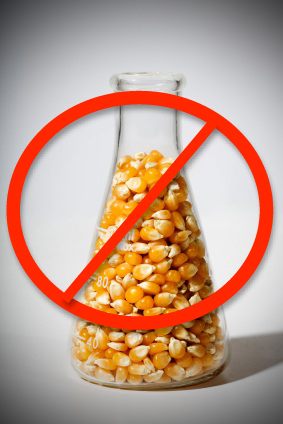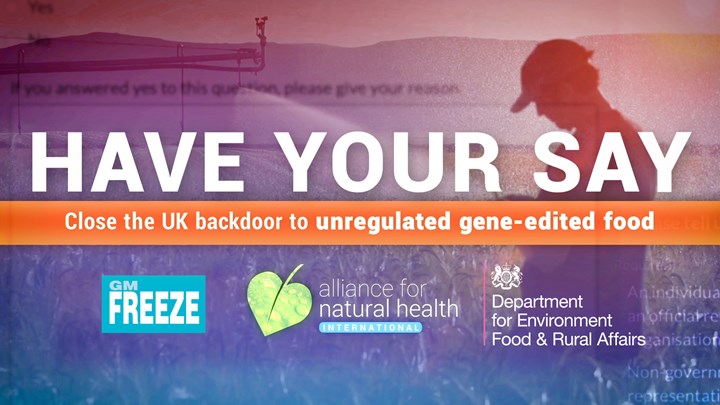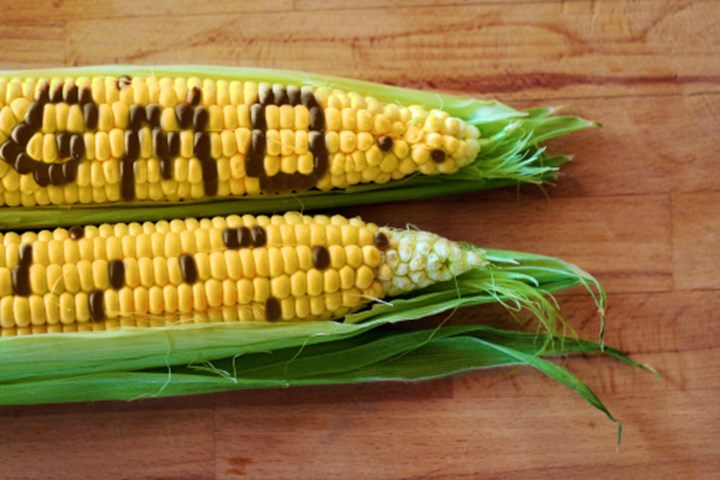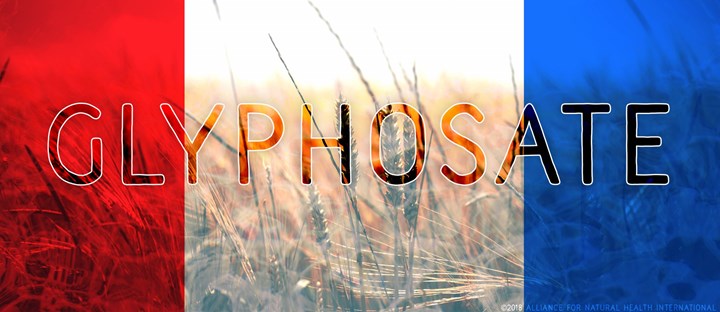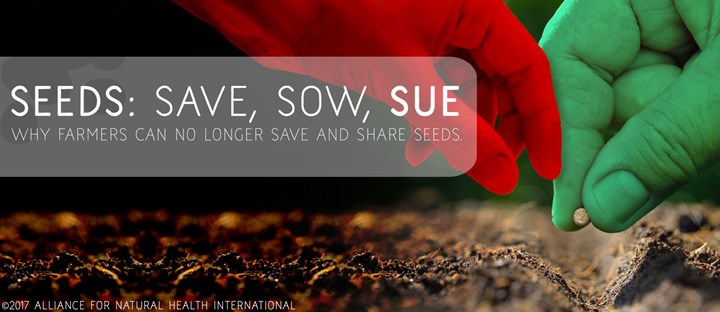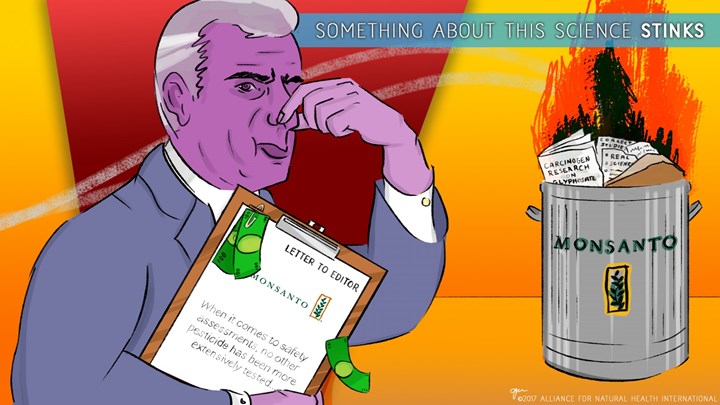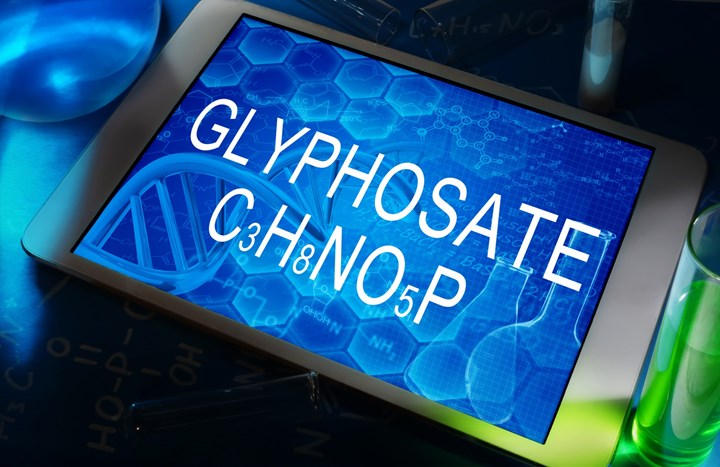Content Sections
- ● What can I do to protect myself, and the environment from GM?
- ● What foodstuffs have been subject to genetic engineering?
- ● What are some of the names of the companies that produce GM crops?
- ● How are food crops genetically engineered?
- ● Surely no GM crops are released into the environment without thorough evaluation of safety?
- ● What are some of the possible health risks from eating GM-containing foods?
- ● What are some the faulty bricks in the shaky foundations of GM?
- ● Misconception 1: The ‘one gene one protein’ hypothesis
- ● Misconception 2: The expression of genes in the crop plant will not be affected by the foreign, inserted gene(s)
- ● Misconception 3: Instability of DNA in genetically modified crops
- ● Misconception 4: Genes from GM crops won’t transfer into the environment
- ● Misconception 5: Biotechnology is needed to feed the world’s expanding population
- ● Might farmers be handing ownership of their seed to someone else if they accept GM?
- ● Is public opinion going to make GM redundant?
- ● Say No to GM
- ● Some online resources relating to the GM controversy
- ● Anti-GM websites
- ● Reading
- ● Related news items
What can I do to protect myself, and the environment from GM?
The ANH upholds the view that consumer resistance to purchasing any GM produce, as well as political pressure, is going to be among the most powerful determinants as to whether the rampage of GM on the natural environment, and on our bodies, is going to continue. In a word, it’s really up to you and what you, your friends and your family are going to do. Are you prepared to avoid consuming any GM produce? (Europeans need only read the labels of packaged or processed foods or buy organic foods to avoid GM.)
Consumers in the US—as well as other parts of the world—can learn a lot about the ways of avoiding GM by going to the website of the Institute for Responsible Technology, its Campaign for Healthier Eating in America, its Non-GMO Shopping Guide and its GM-Free Schools Campaign. Also, look out for the No-GMO logo that’s going to be increasingly found on US produce once the initiative is launched later this year. The initiative currently has the support of food businesses with around $12 billion turnover.
What foodstuffs have been subject to genetic engineering?
Biggest targets for GM
- Soybeans
- Maize
- Oilseed rape
- Cotton
but on a much smaller scale
- Potatoes
- Tomatoes
- Papaya
- Alfalfa and a few other crops have also been
The key traits that have been added to commercial GM crops are herbicide tolerance, which allows farmers to spray such GM crops with herbicide (mostly glyphosate or RoundUp®) to kill weeds while not killing the crop itself, and insect resistance, particularly through the expression of Bt-toxin (a toxin produced by the bacterium Bacillus thuringiensis). Some crops possess both traits and are referred to as ‘stacked’ transgenics.
Over 110 million hectares of agricultural land is currently cultivated with GM crops, around half of this is in the USA, the single largest GM crop cultivator. The global area given over to GM has doubled in the last 5 years.
The US has also allowed the use of a GM-altered (recombinant) bovine growth hormone (rbGH) intended to increase dairy yields, which most other countries refuse to accept on the grounds of the health risks it presents to consumers of dairy products derived from rbGH injected cows. The EU continues to refuse import of dairy products derived from rbGH-treated cows.
Evidence on how pressure can be imposed on other countries through the World Trade Organization (WTO) is well illustrated by the long-running dispute over growth hormone treated beef. The USA, which routinely uses such hormones to promote rapid growth in beef cattle, together with support from both Canada and Argentina, has forced sanctions on the EU for continuing to refuse the import of hormone-treated beef. Based on the EU-imposed trade barrier, the WTO has allowed the US to impose import duties on EU exports that cost $116.8 million annually. An additional CAN$11.3 million a year is levied by the Canadian government on EU exports to Canada. The EU argues that it is compliant with WTO rules because there is solid scientific evidence that hormone-treated beef may be harmful.
Horse trading is the name of the game when it comes to the global food trade, and there is increasing evidence that the EU is slowly caving to pressure over the commercial cultivation of GM crops, an issue that has been the subject of a long-standing trade dispute ever since the EU imposed a 6-year moratorium on GM crops from 1998. The WTO has ruled that the EU’s moratorium is illegal and it is putting increasing pressure on the EU to stop some of its Member States, notably Austria, France, Germany, Greece, Italy and Luxembourg, imposing unilateral bans on GM imports.
Despite widespread public opposition to GM crops in Europe, GM food and animal feed usage in Europe is continuing to grow. The difference in Europe, compared with many parts of the world, including the US, is that there is compulsory labelling of GM-containing foods (at least those that contain more than 0.9% GM). The trouble is, European consumers clearly don’t study labels that carefully and are consuming ever larger amounts of GM-containing produce, as revealed in a recent EU study involving 6 countries, led by scientists at King’s College London.
What are some of the names of the companies that produce GM crops?
- Monsanto
- Bayer CropSciences
- BASF
- Dow AgroSciences
- Pioneer (DuPont)
- Syngenta
How are food crops genetically engineered?
The transfer of DNA (deoxyribonucleic acid)—the two strand spiral of genetic information found in every plant, animal and microorganism cell that controls the development and function of all organisms—from one organism to crop cells is not a clean, surgically-precise procedure. It is a very hit-and-miss process based on faulty foundations.
The genes from the donor organism, or synthetic equivalents, are not neatly spliced into the 'videotape' of the recipient’s DNA. They are forced into the DNA using a range of methods, often with very unpredictable consequences.
A common method of genetic engineering used in the development of GM crops involves the use of a ‘gene gun’. Millions of tiny particles of gold or tungsten coated in selected DNA fragments containing the required gene (gene cassettes) of the donor organism are fired with great intensity at recipient plant cells in the laboratory. An antibiotic marker is added so that cells where DNA has been successfully inserted survive following their dousing with antibiotic. A ‘promoter’, usually a part of the cauliflower mosaic virus 35S (CaMV35S)—actually the naked virus, the virus without its protein coat—is also included to ensure the gene expression is permanently turned on to maximum. This is something that tends not to happen with many traits in non-GMOs. Any surviving cells will have had the antibiotic resistant marker along with the new gene(s) and DNA of the CaMV35S successfully incorporated and can then be cloned to produce the new-to-nature GM crop plant, complete with its new complement of DNA.
The above method of gene insertion has now been superseded, in many cases, by using a bacterial vector. This approach originates from the work of Professor Marc Van Montagu and colleagues at the University of Gent in Belgium in 1975, and involves using a particular bacterium (Agrobacterium tumefasciens) that induces tumours in plants. Actually only a part of the bacterium’s cells is used—the plasmid—which contains essential elements of its DNA without the tumour-inducing sectors. The bacterium possesses an unusual ability, not unlike that of a virus, to insert some of its own DNA into its host. Genetic engineers are able to insert gene cassettes (containing one or more genes) into the tumour-inducing section of the bacterium’s DNA, which then inserts the new genes into the plant cell.
Contrary to what the biotechnology companies responsible for genetic engineering of crops tell us, there is a very real risk that transgenic DNA might directly transfer into unrelated species, a process known as horizontal gene transfer. Find out more about the science on this in an ISIS article published in March 2008.
Surely no GM crops are released into the environment without thorough evaluation of safety?
Wrong. Owing to the fact that regulators have decided under pressure from biotech companies that there is no need to thoroughly evaluate the health and environmental consequences of GM crops because they are viewed as “substantially equivalent” to their non-GM relatives, safety evaluation has been very limited.
One of the most thorough evaluations to-date involved a GM potato that was engineered to produce a lectin (protein) from the snowdrop that is well known for its selective toxicity to insects. The purpose of the genetic modification was to have a potato that would produce its own insecticide and hence reduce the need for conventional insecticides, while still being safe to humans.
The work was conducted between 1995 and 1998 at the Rowett Research Institute in Aberdeen (Scotland) under the leadership of Dr Arpad Pusztai, one of the world’s leading authorities on lectins and previously a pro-GM proponent.
The research findings, published in the prestigious Lancet journal in 1999, still stand as one of the most thorough investigations of the potential human health risks of GM.
The study involved assessing the effects of GM potatoes which had been engineered to express the lectin on young rats. The lectin, on its own, had been shown to be safe to rats when fed at 800 times the concentration at which it occurred in the GM potatoes. The results showed dramatic and unexpected effects that could not be caused by the lectin and could only be associated with the genetic modification.
The results rocked the shaky foundation of the GM industry. Dr Pusztai faced huge opposition from the Royal Society in London, from pro-GM governments, including the UK government and ended up being unceremoniously forced out of his job at Rowett. As increasing evidence for health and environmental risks continue to accumulate, Dr Pusztai is joined by an ever growing band of leading scientific researchers in the GM field who are adamantly opposed to the outdoor release of GM and its incorporation into human food and animal feed.
Read an article by Dr Pusztai, Genetically Modified Foods: Are They a Risk to Human/Animal Health?, which demonstrates the lack of adequate safety evaluation of GM crops. Read an abstract of a recent (2007) review by Dr Joseluis Domingo of the School of Medicine, Rovira I Virgili University, Spain, entitled Toxicity studies of genetically modified plants: a review of the published literature.
What are some of the possible health risks from eating GM-containing foods?
Scientists have revealed a very large number of adverse effects associated with the genetic engineering of crop plants. The following is just a small list of some of the adverse effects that have been documented following exposure findings:
- reduced organ weight
- reduced growth
- reduced fertility
- compromised immune function
- inflammation
- mutations
- allergic reactions
- new diseases
- reduced nutrient content of food
- cancer
- premature death
Probably the most complete and accessible compilation of documented health risks of genetically engineered foods has been undertaken by Jeffrey Smith, author of the bestseller Seeds of Deception (2004, Green Books, Totnes, UK / Yes! Books, Fairfield IA, USA), and his latest book Genetic Roulette: The Documented Health Risks of Genetically Engineered Foods (2007, Yes! Books, Fairfield IA, USA). We strongly recommend all members of the public, academia and governments with concerns about GM foods to read both these books. They can be readily obtained through Amazon.
Alternatively, click here to discover more about the 65 health risks documented in Jeffery Smith’s book.
What are some the faulty bricks in the shaky foundations of GM?
The continued march of GM into our food supply has occurred only because dozens of errors, misconceptions, misrepresentations and even outright lies have been accepted by regulators, governments and unsuspecting members of the public. We look here at just five of the most glaring defective bricks in the unsound foundations of genetic engineering:
Misconception 1: The ‘one gene one protein’ hypothesis
George Beadle and Edward Tatum were awarded the Nobel Prize for proposing this hypothesis back in 1958. They proposed that each gene within DNA coded for the production of a single protein or enzyme. The view formed the bedrock for the development of the genetic engineering of crop plants between the 1970s and 1990s. It allowed the scientists to think of strands of DNA, and the genes on them, like videotape or Lego bricks. You could splice or chop and change the DNA of a crop plant to incorporate whatever trait you so desired. Because the resulting GM crop would then be unique, you could also make a lot of money out of it through its patent.
The Human Genome Project which was completed in April 2003—the largest collaborative scientific project ever conducted—eventually proved this hypothesis to be incorrect. In unravelling the human genome, the project showed that there are only around 30,000 genes in the human genome, a much smaller number than was anticipated. Given that we know about the existence of some 200,000 cellular proteins (including enzymes) in the body, it is clear that some genes must code for more than one protein. Since this time, it has been found that most genes code for multiple proteins and only a very few code for a single one.
Therefore by incorporating a gene for a selected trait, it is highly likely that other, unpredictable consequences will arise. An increasing body of research is now beginning to support this view.
Misconception 2: The expression of genes in the crop plant will not be affected by the foreign, inserted gene(s)
This has again been demonstrated to be a completely false assumption. When the foreign gene is ‘spliced’ into the host plant’s DNA, there is no telling exactly where it will be situated and the foreign genes may have a wide range of unpredictable effects on the native genes in the recipient’s cells. The foreign gene and associated DNA may directly or indirectly cause some native genes to stop producing specific proteins or enzymes they are programmed to produce (‘gene silencing’), while it may increase the expression of others, some of which may have been dormant in the DNA for thousands of years. It may also cause some genes to express themselves differently and unpredictably, giving rise, for example, to allergens or toxins.
The documented increase in allergic reactions in countries in which GM crops are consumed and the death of at least 37 people and illness in up to around 10,000 Americans following the consumption of the genetically modified L-tryptophan dietary (food) supplement in the 1980s are examples of this.
No risks obviously apply to good old non-GM L-tryptophan, which is an essential amino acid found in liberal quantities in chicken and other meats. It acts as a precursor to serotonin, the mood enhancing hormone that prevents so many of us entering states of anxiety and depression and taking SSRI drugs.
L-tryptophan and its intermediate, 5-HTP (5-hydroxytryptophan), have been used safely for decades as food supplements and are invaluable to many thousands. They are a natural part of the food supply and again pose no risk, provided that they are taken in non-GM forms.
Misconception 3: Instability of DNA in genetically modified crops
It was assumed originally by genetic engineers that once the insertion of new genes had taken place and the modified cells had been developed into viable and crop plants, that their DNA would be relatively stable—or at least as stable as non-GM crops. This has been found to not be the case. It seems that the process of genetic engineering—where foreign DNA, often from a completely unrelated species—is forced into the DNA of a plant, making its DNA much less stable. As such, the DNA of GM crops is subject to unpredictable changes, some of which may be harmful, or even lethal, to other organisms.
Misconception 4: Genes from GM crops won’t transfer into the environment
For years the biotech industry argued that the movement of transgenic DNA into non-GM crops or weeds or other plant, animal or microorganism species would not occur and could be guarded against by ensuring buffer zones between GM crops and non-GM ones.
It is now almost universally accepted that this is an inevitable consequence of increasing the hectarage of GM. It’s referred to as horizontal gene transfer or outcrossing and its impact could be catastrophic in either the short or the long term.
Misconception 5: Biotechnology is needed to feed the world’s expanding population
This is the big and emotive argument being pushed around by governments. It pulls at our heart strings and we are told that genetic engineering is merely an extension of plant breeding techniques that have been ongoing for centuries. Wrong again. Firstly, plant breeding works within the laws of nature. Nature doesn’t allow you to incorporate DNA from an unrelated species into a crop plant. It doesn’t, for example, allow you to put spider genes into maize plants. It also has a very specific rule system for allowing recombination of DNA between related species. It is therefore a gradual process and does not involve the forced introduction of foreign DNA, antibiotic marker genes and naked cauliflower mosaic virus into its native DNA.
There’s little evidence that GM crop plants consistently give better yields, or that such yields can be sustained over many generations. There’s also little consistent evidence that GM crops are more nutritious and there is a growing body of evidence suggesting that they are less nutritious and pose considerable health and environmental risks.
Then there’s the huge issue of who controls the seed supply. Biotech companies and pro-GM governments tell us that GM is the answer to food shortages in developing countries, as well being the most cost-effective way of producing cheap food for the developed world. But around 2 billion people on the planet today are subsistence farmers who rely on raising their own seed. GM takes this capability away from subsistence farmers and makes them depend on a small handful of biotech companies for their seeds. This concept flies in the face of all that has been learned about re-establishing self-sufficiency in rural communities in developing countries.
Might farmers be handing ownership of their seed to someone else if they accept GM?
The approach favoured by the biotech giants also flies in the face of findings on the state of agriculture made over 4 years of study by a collaboration of 400 scientists from 60 countries, which are detailed in a 2,500 page report— released in April 2008—as part of a UN project, the International Assessment of Agricultural Knowledge, Science and Technology for Development (IAASTD). The executive summary of the report concludes that GM raises numerous contentious issues for developing countries, ranging from gene transfer, contamination of organic crops, undermining of local practices, reduced food security and unpredictable or reduced yields. In short, the scientists are saying that GM—at least in its present form—is not the solution to food shortages in the developing world.
Many developing countries have been at the forefront of resisting the shift to GM. Their governments, which by and large accepted agrochemicals in the past—many of which were banned in the west owing to their excessive health or environmental hazard—have not been so forgiving over GM. They are alive to the huge health and environmental risks. They understand the predicament it puts them in by becoming dependent on patented seeds from western biotech companies.
Large tracts of the Amazon rainforest, one of the most important areas of biodiversity in the world, is presently being flattened to make space for GM soyabeans to feed livestock in the western world. We have no idea what the consequences might be, but the existing evidence would suggest that widespread planting of GM crops poses a catalogue of potentially dire environmental risks.
One of the clearest pieces of evidence demonstrating the risk was a study in the US showing that pollen from GM maize kills Monarch butterflies.
Whatever happened to the precautionary principle that has helped to save many a whale, penguin and polar bear?
Is public opinion going to make GM redundant?
Although more and more countries are resisting increasing cultivation of GM, there is still enormous pressure from biotech companies which is being felt particularly at a governmental level.
The EU as a whole, and even some European countries that have previously supported the EU’s moratorium against further commercialisation of GM, are becoming more pro-GM. This is particularly the case with the UK government.
It is clear that the biotech companies and governments are increasingly trying to prepare the public to be more amenable to accepting GM.
Do you know if there's GMO's in your food? Did the animal whose meat? you're eating feed on GM soya or maize?
The World Trade Organization (WTO), the ‘policeman’ of global trade, regards the banning of GM as a barrier to trade and has been engaged in disputes with countries to restrict GM. Given that Europe has historically represented a big export market for agricultural products from the US and Canada, the US and Canadian governments, supported by the Argentinian government initiated a dispute against the European Union which is still ongoing.
Our key concern in Europe is that the European Commission itself is not fundamentally anti-GM. It is the public in Europe that represent the key opposition to GM—not the governments. In fact, although the European Commission doesn't generally admit it, it is actually pro-GM. There is mounting evidence that the EU will slowly move into line with the US, to increase the number of GM registrations, to increase the land area within Europe given over to GM crop cultivation, and slip ever greater amounts of GM into our food. Leaked documents have revealed secret plans by the European Commission, and representatives of the 27 EU Member States to do just this.
Disconcertingly—as is so often the case in other matters—those at the tough end of the socio-economic scale will pay the highest price in health terms. This group tends to consume the largest amounts of processed foods, the perfect disguise for GM soya and maize products and derivatives.
At a global level, apart from the WTO from its pro-big corporate position as arbitrator over trade disputes, there is also considerable involvement of Codex. The Codex Committee on Food Labelling, hosted by the pro-GM Canadian government, is providing the key battleground for governments, corporation-sponsored NGOs and consumer advocates to fight out labelling requirements for GM foods. There is a major and growing divide between those countries, headed by the US and Canada, that are pro-GM and opposed to compulsory labelling of GM ingredients in foods, and those, represented by some EU member States, many African and other developing countries, that are adamant that mandatory labelling of packaged foods is essential as a means of offering consumers choice. In other words, they support the fundamental human right—the right to knowledge.
Anything less than compulsory labelling, on the basis of the available evidence and the risks and uncertainty over GMOs is—in our view—criminally negligent.
Say No to GM
Remember: if you support the principles of natural health which serve to offer the body the appropriate internal and external environment to allow the optimal function of self-healing mechanisms within the body, ALWAYS say NO to GM! Anyone passionate about natural health has to say NO to GM.
That means making sure you know what you're eating and buying, and making sure (as far as you can) that you are not knowingly consuming GM directly in your food or indirectly in meat produced from animals fed GM-soya or GM-maize. Presently buying organically certified food is one of the simplest ways of minimising your intake—but even this doesn't necessarily eliminate your exposure altogether. It is particularly important for us to work to ensure that all children—who are especially susceptible to GMOs—are not unknowingly exposed to GM.
Help people to understand why we are faced with pro-GM spin from governments, regulatory agencies, international regulatory bodies such as the Codex Alimentarius Commission and the World Trade Organization.
Work to ensure safety evaluations by regulatory authorities are massively extended and made transparent. Based on the current scientific evidence, no objective safety evaluation could ever approve the use of GM for release into the environment.
And don't forget to tell as many people as you can—people you know or those you can reach out to—about GM and its very considerable risks.
Copy this link: http://www.anhcampaign.org/campaigns/say-no-to-gm
...and send it by email to the people you care about.
Some online resources relating to the GM controversy
Anti-GM websites
Arpad Pusztai’s Homepage
GM Freeze
GeneWatch
GM Watch
Greenpeace
Friends of the Earth
Soil Association
Organic Consumers Association
Institute for Responsible Technology
Navdanya
Non-GM Farmers
GMO Compass
GMO Safety
GM Free Ireland
GM Free Cymru (Wales)
Institute of Science in Society
Lobbywatch.org
Physicians and Scientists for Responsible Application for Science and Technology (PSRAST)
Pro-GM websites
Monsanto website / “conversations about plant biotechnology”
European Association of Bioindustries
Sense About Science / GM and Plant Science page
Skeptico Blog on Genetic Engineering
In addition, the following links are to profiles created by Lobbywatch.org (UK author and journalist George Monbiot) about organisations that have been staunchly pro-GM:
Institute of Economic Affairs
European Science and Environment Forum
International Policy Network
Sustainable Development Network
Competitive Enterprise Institute
American Enterprise Institute
Promoting independent research and public debate on the impacts of biotechnology
Testbiotech Institute for Independent Impact Assessment in Biotechnology
Reading
Jeffrey Smith, author of the bestsellers Seeds of Deception (2004, Green Books, Totnes, UK / Yes! Books, Fairfield IA, USA), and his latest book Genetic Roulette: The Documented Health Risks of Genetically Engineered Foods (2007, Yes! Books, Fairfield IA, USA).
We strongly recommend all members of the public, academia and governments with concerns about GM foods to read both these books. They can be readily obtained through Amazon.
Alternatively, click here to discover more about the 65 health risks documented in Jeffery Smith’s book.
Related news items




